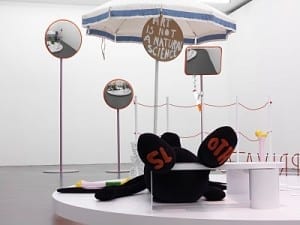Milan’s Gio Marconi Gallery’s latest offering is Quality Interiors by Nikolas Gambaroff, which runs until 18 May, and sees the New York-based artist’s first solo show at gallery. The show is comprised of new works including a collaboration with designer and Nilufar Gallery owner Nina Yashar, as well as a staple marks from his Gambaroff’s career to date.
The first room sees a minimalist layout: white walls are electrifyingly emphasized by the lighting and an overwhelming acknowledgement of the spatial solitude between the works. This becomes more apparent in formulating a sense of isolationism, culminating in individual dialogues between each work and the viewer. It is within the parameters of this serene isolation that one is propositioned with a series of canvas frames, tightly wrapped polyethylene terephthalate coloured in sickly flesh tones that dominates and haunts the colour pallet of the exhibition at times this becomes alluring yet at times repulsive. As the material is stretched taught over the canvas frames, rips have been inflicted upon it like gashes in skin, personifying works with empathy and pain. This formula of wrapping canvas frames persists throughout the gallery with elements of experimentation and modification.
The polyethylene terephthalate seems to have two apparent and strikingly different aesthetics; the first is a polished metallic gloss that gives the impression of a futuristic high quality industrial material. This is best portrayed at the far end of the room. A vertically rectangular canvas with an LED lights at the bottom behind the canvas displays a stream of text partially obscured by the thin sheet of material that reflects the rest of the room. The second is a matt finish which bares more resemblance to the painterly quality that one would expect to find in a gallery. Relationships form between technology and the reflective psudo-metalic appearances of the polyethylene terephthalate, which quite astutely counteract a pair of limp, lifeless polyethylene terephthalate meshes displayed side by side on a wooden table the other end of the room – this is a very physical exchange and is brought out specifically by the different methods of displaying each one.
In the second part of the gallery one is greeted by a collection of mannequins as part of the collaboration with Nina Yashar, which is hand painted in a familiar sickly flesh tones. The walls are again sporadically dressed with reflective and matt wrapped canvases, mimicking the various items of clothing draped on the mannequins. The inclusion of the mannequins in this part of the exhibition transforms one’s interpretation of the work, as the mannequins’ autonomy and faceless perpetual gaze become infatuated with the viewer’s negotiation of their objective in terms of association. The title, Quality Interiors, lends some degree of a framework on which to build but doesn’t solidify an answer. However does it have to? Throughout the exhibition an unlikely and compelling list of materials, surface textures and technologies have been utilized and manipulated by Gambaroff in an unconventional context where one would expect to find paint and vice versa. Therefore, from this deduction is a subversive analysis and dissection re-evaluating what painting is today.
Nikolas Gambaroff: Quality Interiors, until 18 May, Gio Marconi Gallery, via Tadino 15, 1-20124 Milan.
William Davie
Credit
1. Installation view: Quality Interiors, Giò Marconi, 2013.





